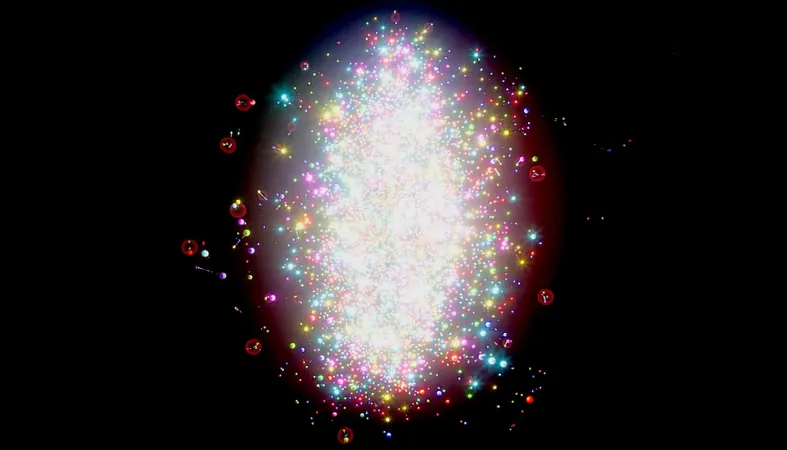
Unlocking the Secrets of the Early Universe with Shape-Shifting Collisions!
2025-09-18
Author: Yu
A Groundbreaking Discovery at the Large Hadron Collider
This summer, scientists at the Large Hadron Collider (LHC) achieved a monumental breakthrough by initiating high-energy collisions between light nuclei, specifically oxygen and neon. These collisions not only confirmed the intriguing 'bowling-pin' shape of neon nuclei but also unveiled a revolutionary method to investigate the extreme states of matter resembling those shortly after the Big Bang.
Revolutionizing Our Understanding of the Quark-Gluon Plasma
Traditionally, the LHC focused on smashing heavy ions like lead and xenon to create a quark-gluon plasma (QGP)—a hot, dense state of matter that existed just microseconds after the Universe's inception. However, this time around, the LHC was ingeniously reconfigured to explore lighter ions, allowing physicists to delve deeper into the QGP’s characteristics and how it evolved.
Smaller, Yet More Informative Collisions!
By using lighter ions like oxygen, researchers can meticulously study the minimum nucleus size required to generate the QGP. Surprisingly, these lighter nuclei are not only smaller but also possess unique shapes, significantly enhancing our understanding of particle collisions. The distinct elongated shape of the neon nucleus, likened to a bowling pin, has been revealed with greater clarity through these recent results.
Flow Patterns That Tell a Story
The experiments concentrated on analyzing subtle flow patterns in the particles ejected during the QGP’s expansion—a phenomenon driven by slight distortions in the collision zone. What's astonishing is that these flow patterns can be described using regular fluid dynamics equations, allowing scientists to investigate both the QGP’s properties and the geometry of colliding nuclei with unprecedented accuracy.
Astounding Results Affirm Theories!
Recent measurements from the experiments, including the specialized ALICE as well as the general-purpose ATLAS and CMS, uncovered significant elliptic and triangular flows in the oxygen and neon collisions. Notably, these flows depend heavily on the nature of the collisions, whether they are glancing or direct hits—supporting the theory of nuclear geometry and the bowling-pin structure of neon.
A Symposium of Knowledge—Collaborative Insights
In a complementary twist, the LHCb collaboration corroborated the bowling-pin shape of the neon nucleus with additional findings from lead-argon and lead-neon collisions recorded in 2024. With further analysis underway on the oxygen and neon collision data, these revelations are set to reshape our understanding of the very fabric of matter as it emerged from the Big Bang.
What This Means for the Future
CERN’s Director for Research and Computing, Joachim Mnich, emphasized the significance of these results, stating, 'These findings bring fresh perspectives on nuclear structure and how matter emerged after the Big Bang.' This pioneering research heralds a new chapter in particle physics as it propels our understanding of the early Universe to thrilling new heights.
 Brasil (PT)
Brasil (PT)
 Canada (EN)
Canada (EN)
 Chile (ES)
Chile (ES)
 Česko (CS)
Česko (CS)
 대한민국 (KO)
대한민국 (KO)
 España (ES)
España (ES)
 France (FR)
France (FR)
 Hong Kong (EN)
Hong Kong (EN)
 Italia (IT)
Italia (IT)
 日本 (JA)
日本 (JA)
 Magyarország (HU)
Magyarország (HU)
 Norge (NO)
Norge (NO)
 Polska (PL)
Polska (PL)
 Schweiz (DE)
Schweiz (DE)
 Singapore (EN)
Singapore (EN)
 Sverige (SV)
Sverige (SV)
 Suomi (FI)
Suomi (FI)
 Türkiye (TR)
Türkiye (TR)
 الإمارات العربية المتحدة (AR)
الإمارات العربية المتحدة (AR)